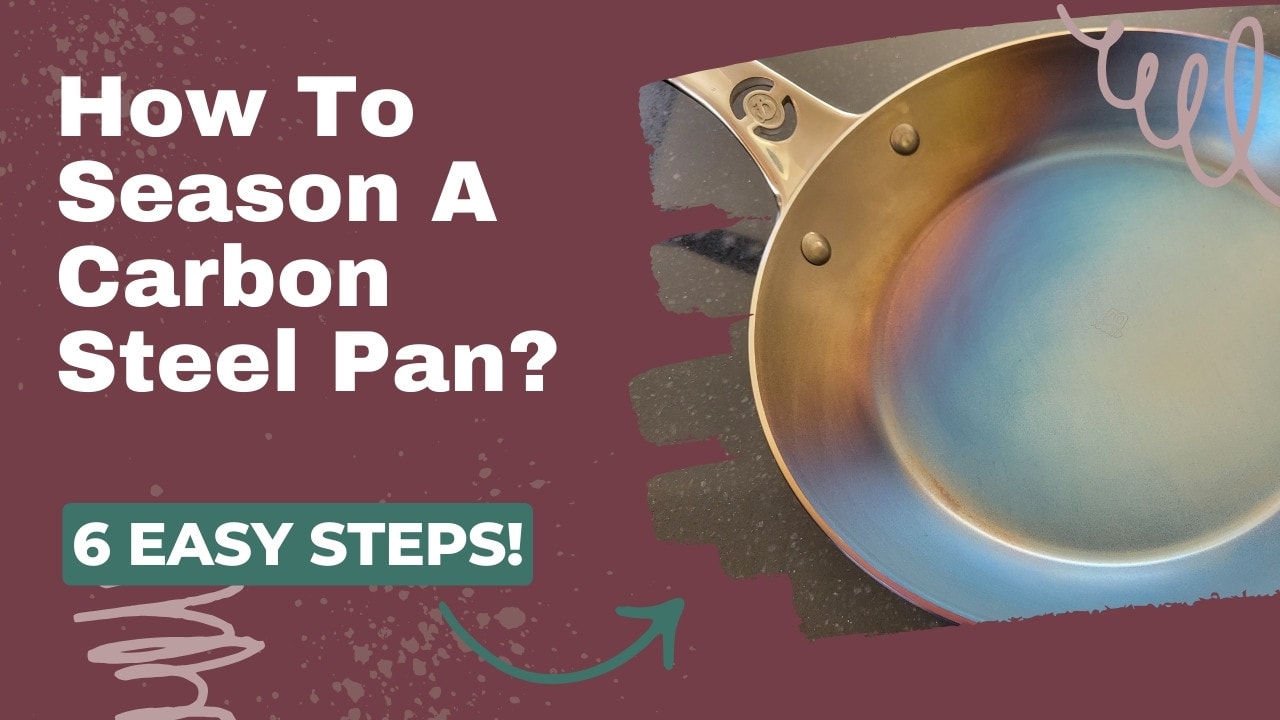Seasoning a carbon steel pan is not difficult. Like any other culinary skill — from sharpening your knives to making meringue to using a pressure cooker – seasoning a pan feels intimidating until you’ve done it a few times.
Speaking for myself, I let my husband do all the seasoning on our carbon steel skillets for the first two or three years that we owned them. But since I’ve started doing it myself, I’ve discovered that – unlike a meringue or pressure cooker – carbon steel is really forgiving. If you mess up the seasoning, just try it again!
How To Season Carbon Steel Pan?
The basic steps for how to season a carbon steel skillet are:
- Remove wax coating from the factory.
- Dry and warm the pan on low heat.
- Apply an itty-bitty bit of a high smoke point oil and rub it in thoroughly.
- Heat the pan on medium while wiping off any excess oil.
- Continue to heat until the pan has finished smoking and changed color.
Alternatively, after step 3 you can heat your pan in a 400°F oven instead of on the stovetop.
In this article, I’ll give detailed instructions for both of these methods and share some troubleshooting tips.
Why Do You Need to Season Carbon Steel Pans?
Seasoning is the process of building layers of polymerized oil onto a metal pan. The seasoning protects the pan from rust and prevents food from bonding to the pan. Food will never slide around on carbon steel quite the way it does on a Teflon-coated pan, but with the right cooking techniques, well-seasoned carbon steel can be pretty nonstick.
What You Will Need
To season your carbon steel pan – whether it’s a dainty egg pan or a big family wok – you’ll need a few common items.
In this tutorial, I’ll be seasoning my de Buyer Mineral B Pro 8” fry pan.
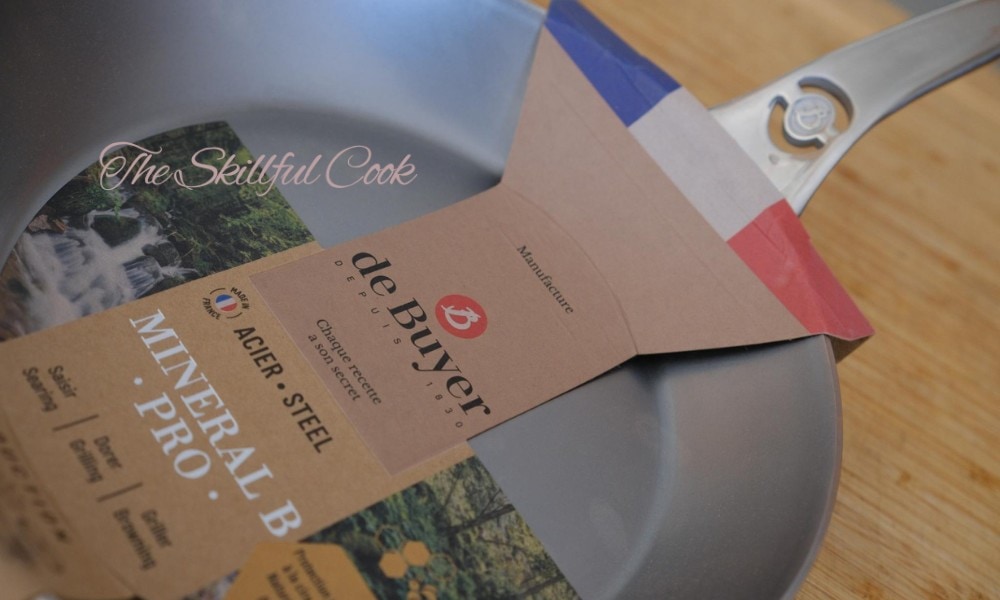
1. Prepare the Pan
If a carbon steel pan doesn’t come pre-seasoned, it will almost certainly have a layer of oil and beeswax on it to protect it during shipment. So your first step in seasoning a brand-new carbon steel pan is to wash it with soap, hot water, and a mild scrubbing pad to take off as much wax as you can. Some people like to use salt as a mild abrasive to help remove all the coating.
If your pan isn’t new, you still should make sure it’s as clean as possible before seasoning it. Any carbonized food bits stuck to your pan will ruin your chance at a clean, even, nonstick surface. You’re going to be seasoning your pan anyway, so go ahead and use a chainmail scrubber or steel wool to get burnt bits off.
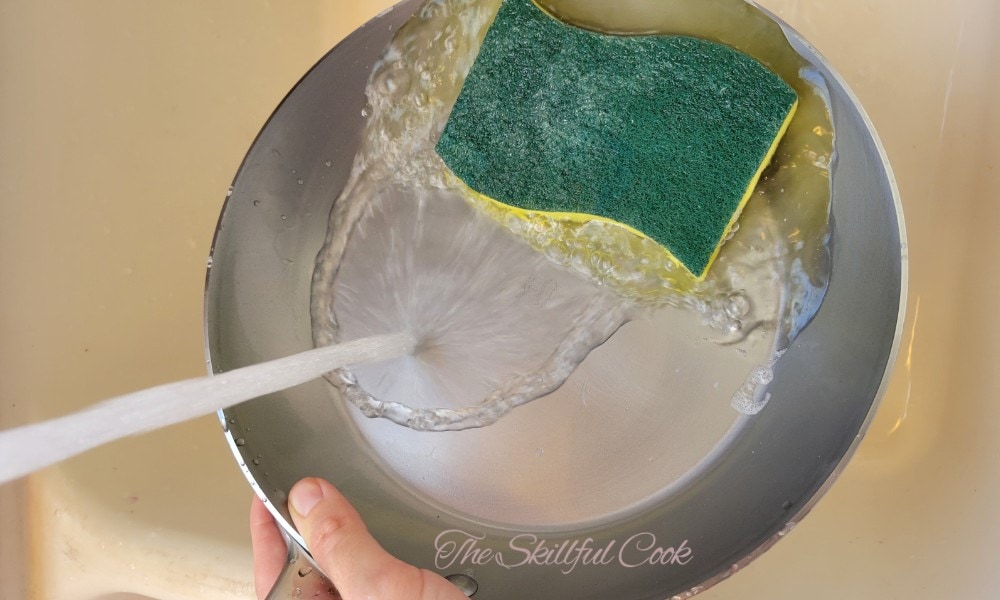
If you’re planning to season your pan in the oven, you should preheat your oven at this point.
2. Preheat the Pan
Preheat your pan on the stove on low, even if you plan to use the oven for baking on oil later. You don’t need to get it ripping hot right now; just warm.
Preheating the pan serves two important purposes. First, it gets your pan bone dry. Second, as the metal expands with the heat, it exposes microscopic irregularities in the metal (which some people refer to as “pores”). When these irregularities are “open,” they more effectively trap the oil.
3. Blue the Steel (Optional)
“Bluing” your carbon steel is totally optional. (See the section below for why some chefs choose to do this.) Bluing only works on brand new or stripped bare carbon steel pans – not on ones that have been seasoned even once before.
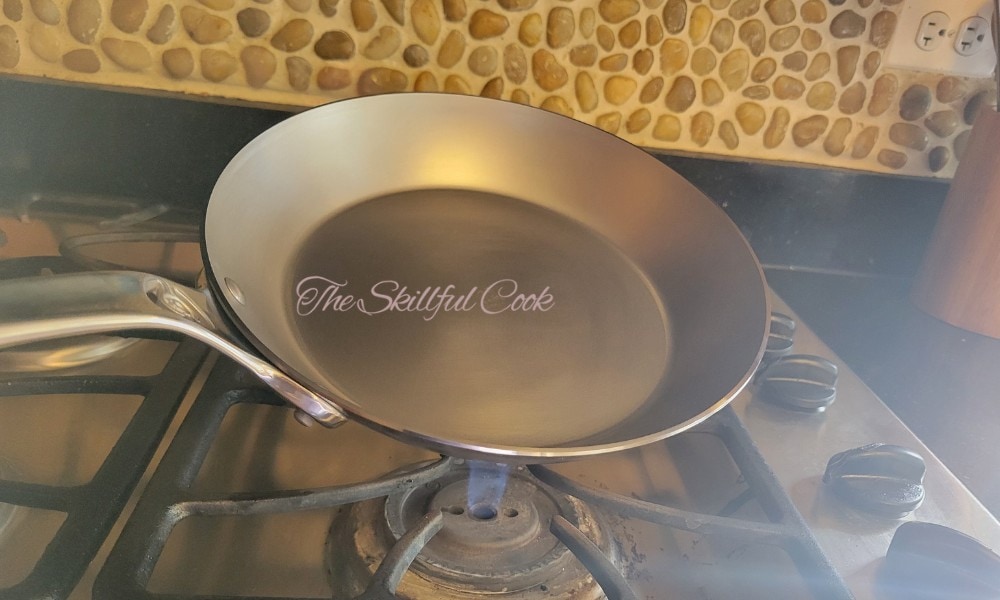
To blue your pan, hold it over a gas flame, dry and empty, until the pan begins to change color. You may see it turn from iridescent blue to bronze to gray as a layer of oxide develops. You can choose to stop at any point in this process; whenever the pan has reached the color that looks good to you. Move the pan around to get the bluing effect across the pan.
I chose to blue my de Buyer pan before seasoning it, and I can’t get over how beautiful the steel became! I was careful to bring it up to heat slowly, heating around the edges of the pan instead of applying heat to the direct center to avoid warping.
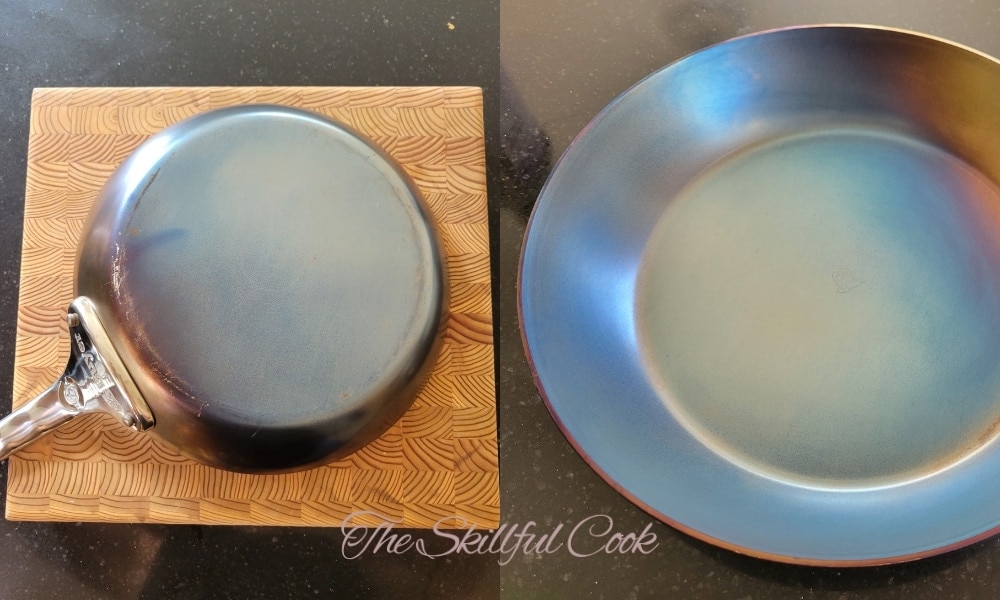
4. Apply Oil Sparingly
While the pan is still warm but not smoking hot, wipe it with oil. You can add a few drops to the pan and wipe it around with a rag or paper towel. To prevent getting too much oil on the pan, I like to use my mother-in-law’s method and dip a paper towel in oil before rubbing it onto the pan. This helps avoid getting too much oil anywhere.
You can apply oil to both the inside and the outside of your pan – especially if you are planning to season it in the oven. Avoid getting it on the handle if you can, though.
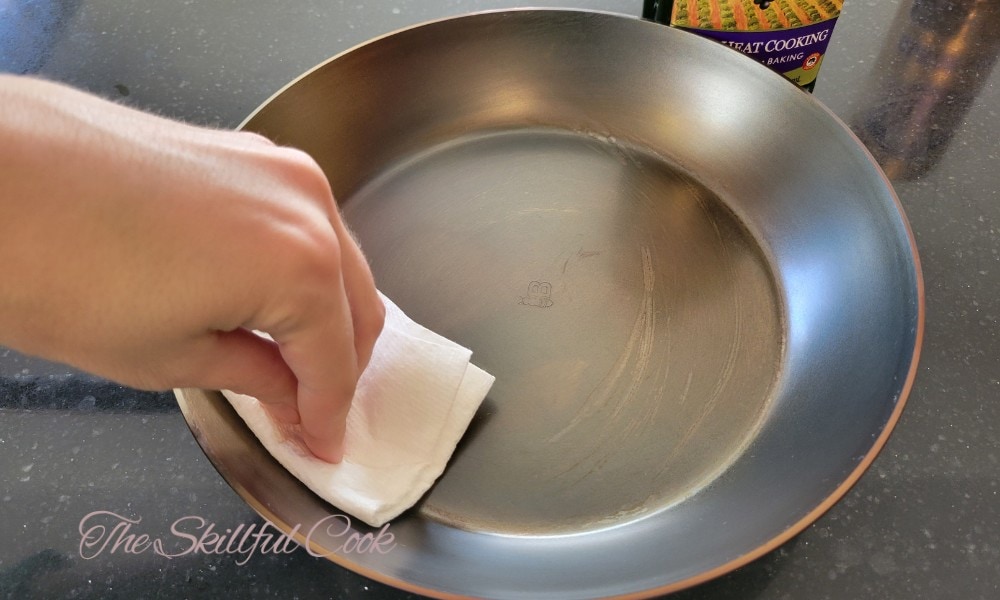
5. Wipe Off Excess Oil
This is the step where most people go wrong: You have to wipe off the oil like you didn’t even want it there in the first place! Get a clean rag or paper towel and rub, rub, rub the inside and outside of your carbon steel pan. You want to barely be able to tell that there’s oil on the metal. Dripping oil or a thick glossy coat will result in sticky spots that are really hard to get off.
6. Heat The Pan
Now it’s time to heat the pan until the oil hardens! You have two options here – stovetop or oven. I’ll dig into the pros and cons of each method in the FAQ section below. For now, here’s the how-to steps:
In the Oven
Place your pan upside-down in an oven heated to between 400°F and 500°F. The oven needs to be hotter than the smoke point of the oil you used to coat the pan. Turning the pan upside-down prevents oil from pooling in the bottom of the pan and making it sticky. Hopefully, you wiped enough oil out of your pan that it wouldn’t drip or pool anyway, but you can place a sheet of aluminum foil under your pan in the oven to catch drips, just in case.
Bake the pan for between 1-2 hours, until the oil is fully hardened and isn’t sticky, and the pan has changed color.
Caution! Only use the oven method for seasoning if your pan has an oven-safe handle (usually one made of steel). If the handle has a silicone cover, like the Misen carbon steel pan, remove it before placing it in the oven.
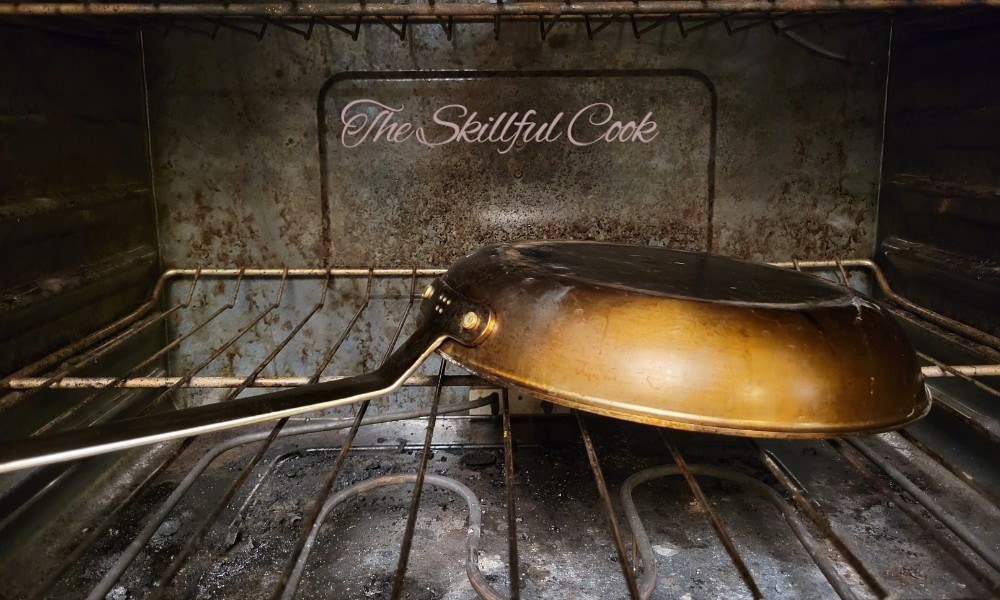
On the Stove
You can season a carbon steel pan on any kind of stovetop – including electric or induction – but it arguably works the best on gas.
No matter your burner type, bring the pan up to temperature slowly. Carbon steel is prone to warping if it’s heated too quickly. Turn your stove to medium heat, then to high, burning the oil onto the pan. The pan should change color – usually to bronze at first seasoning – as it forms a polymer coating. Move the pan around on the burner to heat every part of it until the coating has visibly formed, smoking has mostly stopped, and there’s no sticky oil left.
As it heats, the irregularities in the pan may release beads of oil. If you see these forms, grab a paper towel and, holding it with tongs so you don’t burn yourself, wipe away any visible drops of oil. Continue to heat the pan until smoking stops.
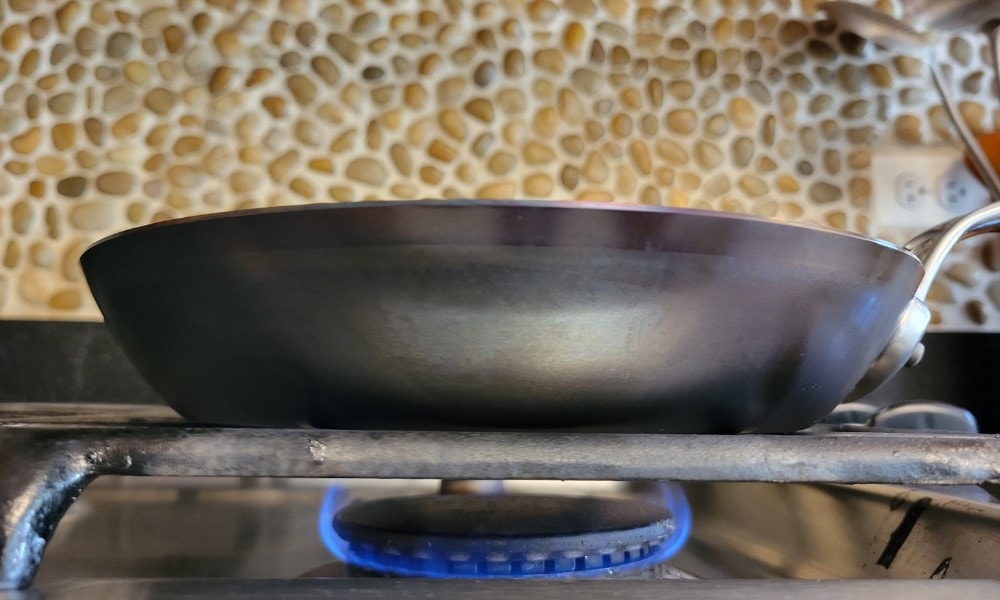
7. Repeat or Just Start Cooking
Congratulations! When you take these steps, you’ll have a great first coat of seasoning on your pan. You can start to cook with it, letting the polymer layers build with time, or you can let the pan cool and repeat these steps again.
I put two coats of seasoning on my de Buyer pan and then sauteed some zucchini. It turned out so well that I decided to try scrambled eggs next – and they slid right off the pan!
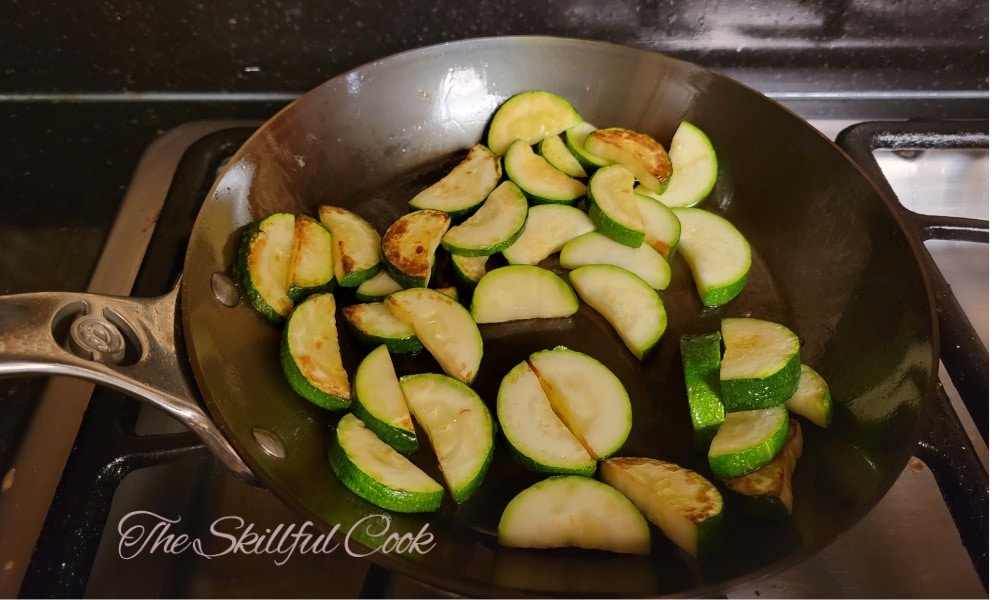
Do you need to season a carbon steel pan every time you use it?
Nope! Once you’ve given your pan a good solid seasoning, careful cooking with it is the best way to build more layers of “nonstick” coating. Emphasis here is on careful cooking. While your pan is building its first layers of seasoning, go gentle on it.
Don’t throw eggs or acids on it right away. Start with greasier foods or simple sauteing. Cook with plenty of oil. Avoid a situation where you’ll have to pull out the chainmail scrubber and attack bonded proteins. As the seasoning develops, you can put your pan through tougher tests or cook with gradually less oil.
If your pan ever appears dry or the seasoning is visibly flaking, you can definitely choose to give it an extra round of seasoning at any time.
Is Oven or Stovetop Better for Seasoning Carbon Steel?
Stovetop seasoning is necessary when a pan’s handle isn’t oven-safe. It takes less time in total, but the process is more hands-on. Honestly, I find it satisfying to watch the seasoning happening in front of me, which is why I chose to season my de Buyer pan on the stovetop.
Oven seasoning is probably the safer method, and it’s arguably better because it exposes the whole pan to even heat. However, some ovens may not heat hot enough to produce a fully polymerized seasoning.
And what about the smoke? Either method will produce some smoke. If you prefer to clear out the smoke with windows and a range fan, then use the stovetop. If your oven has an exhaust fan that vents to the outdoors, by all means, use the oven.
That said, neither seasoning method should produce tons of smoke. If it does, you didn’t wipe off enough oil!
Traditional Seasoning with Potato Peels and Salt
A traditional method of seasoning carbon steel is to cook potato peels and salt together in a pan with lots of oil. This is the method that many YouTube cooks and some French cookware companies – like Mafter Bourgeat – recommend for its simplicity.
The salt removes residual factory wax, and the starch from the potato peels may positively benefit the seasoning in some way. I’m not sure whether the potato skins have a function that can be explained by science or are simply a readily available, low-moisture food scrap to push around your pan – but either way, this seems to be a time-honored technique.
Additional Thoughts, Tips, and FAQ
Some hobbyist metalworkers like to sand their carbon steel pans down with 400-grit or 800-grit sandpaper before seasoning, claiming that this helps the seasoning bond better. Since the need for this would depend on the brand and finish of your pan, it’s something you’ll have to experiment with yourself. It should never be necessary with a brand-new pan from the factory.
However, if you’re trying to totally strip and recondition a carbon steel pan, especially one that’s pitted, you may choose to sand it or buff it.
Should You Blue A Carbon Steel Pan Before Seasoning?
Bluing carbon steel is traditionally done on Asian woks but less often on fry pans. The extremely high heat required for bluing puts a pan at risk of warping, but it can be beneficial if done carefully.
Bluing – also known as annealing or tempering – means heating a bare carbon steel pan before you put oil on it until it turns bluish or orange-colored. This happens because a layer of black iron oxide (Fe3O4) forms on the pan. This oxide layer doesn’t necessarily help the seasoning last longer, but it does help protect the pan from red iron oxide – a.k.a. rust.
Bluing a pan at home is only possible at home if you use a gas stove. However, manufacturers such as Made In and de Buyer sell factory-blued carbon steel pans.
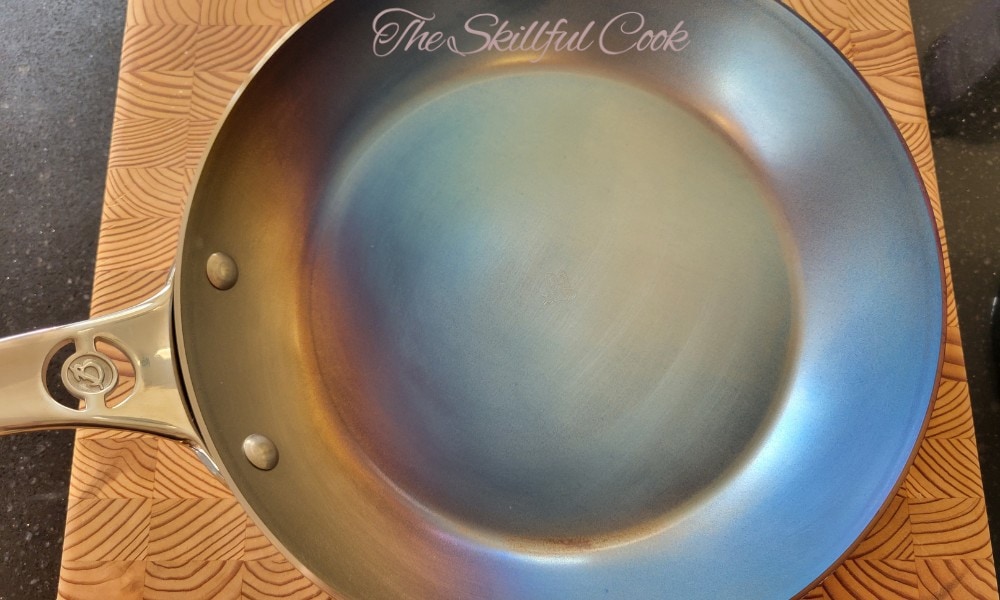
What Color Should a Carbon Steel Pan Be After Seasoning?
After its first seasoning, a carbon steel pan may look blue, bronze, orange, brown, or blotchy. All of these colors are perfectly fine! High-quality carbon steel turns beautiful jet black in time if it’s cared for properly.
What Oil is Best for Seasoning Carbon Steel?
The best oils for seasoning carbon steel include grapeseed, sunflower seed, refined peanut oil, and canola oil. Look for a refined oil with a high smoke point and low fiber content. Butter, virgin olive oil, and unrefined coconut oil are not suitable for seasoning because the solids in these oils will burn and create a mess on your pan.
Flaxseed oil is popular for seasoning because it polymerizes quickly, but many people find it flakes off easily, too.
Check out this research-based guide to good oils for seasoning carbon steel.
Do You Need to Season Your Pan if it Comes Pre-Seasoned?
Companies like Lodge and Misen sell “ready to cook” pre-seasoned carbon steel pans. In my experience, the seasoning will work okay if you treat them gently and cook with lots of oil early on. But companies don’t put a real thick factory seasoning on their pans because if they did, they’d risk coming out blotchy and commercially unattractive.
So if you really want to put a pre-seasoned pan through its paces, you should season it at home first.
What if the Pan is Sticky or Gummy?
If you have brown sticky or gummy spots on your pan, those areas had too much oil on them, and the oil didn’t fully polymerize. If it’s super sticky and you used the right kind of oil, you can try to heat the pan again to polymerize those spots completely. But you may be better off scrubbing them with detergent and re-seasoning the pan.
Conclusion
If you were at all hesitant about seasoning your carbon steel pan, I hope this guide gave you the confidence that you can totally do it! The process is not just simple but also super rewarding as you see a bare piece of metal turn into a powerhouse cooking tool right before your eyes.
Do you have any favorite tricks for seasoning carbon steel? What kind of pan are you going to season next? Let me know how it goes in the comments!

